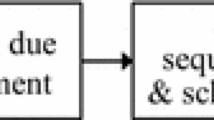Abstract
Due-date assignment (DDA) is the first important task of shop floor control in wafer fabrication. Due-date related performance is impacted by the quality of the DDA rules. Assigning order due dates and timely delivering the goods to the customer will enhance customer service and competitive advantage. A new methodology for lead-time prediction, artificial neural network (ANN) prediction is considered in this work. An ANN-based DDA rule combined with simulation technology and statistical analysis is developed. Besides, regression-based DDA rules for wafer fabrication are modelled as benchmarking. Whether neural networks can outperform conventional and regression-based DDA rules taken from the literature is examined.
From the simulation and statistical results, ANN-based DDA rules perform a better job in due-date prediction. ANN-based DDA rules have a lower tardiness rate than the other rules. ANN-based DDA rules have better sensitivity and variance than the other rules. Therefore, if the wafer fab information is not difficult to obtain, the ANN-based DDA rule can perform better due-date prediction. The SFM_sep and JIQ in regression-based and conventional rules are better than the others.



Similar content being viewed by others
Abbreviations
- DDA:
-
due-date assignment
- ANN:
-
artificial neural network
- BPN:
-
back-propagation network
- SFC:
-
shop floor control
- AI:
-
artificial intelligence
- TWK:
-
due-date prediction rule based on total amount of works
- SLK:
-
due-date prediction rule based on slack time
- NOP:
-
due-date prediction rule based on number of operations
- JIQ:
-
due-date prediction rule based on current queue length in system
- JIBQ:
-
due-date prediction rule based on queue length in bottleneck station
- WIP:
-
work in process
- PSP:
-
pre-shop-pool
- KFM:
-
regression-based due-date prediction rule considering key factor
- SFM:
-
regression-based due-date prediction rule considering significant factors
References
Chung SH, Yang MH, Cheng CM (1997) The design of due date assignment model and the determination of flow time control parameters for the wafer fabrication factories. IEEE Transaction on Component, Packaging, and Manufacturing Technology—Part C 20:278–287
Smith ML, Seidman A (1993) Due date selection procedure for job shop simulation. Comput Ind Eng 7:297–320
Cheng TCE, Gupta MC (1989) Survey of scheduling research involving due date determination decisions. Eur J Oper Res 38:156–166
Eilon S, Chowdhury IG (1976) Due-date in job shop scheduling. Int J Prod Res 14:223–138
Vig MM, Dooley KJ (1991) Dynamic rules for due-date assignment. Int J Prod Res 29:1361–1377
Weeks JK (1979) A simulation study of predictable due-dates. Manage Sci 25:363–373
Kaplan AC, Urnal AT (1993) A probabilistic cost-based due date assignment model for job shops. Int J Prod Res 31:2817–2834
Enns ST (1993) Job shop flow time prediction and tardiness control using queue analysis. Int J Prod Res 31:2045–2057
Smith CH, Minor ED, Wen HJ (1995) Regression-based due date assignment rules for improved assembly shop performance. Int J Prod Res 33:2375–2385
Philipoom PR, Rees LR, Wiegmann L (1994) Using artificial neural networks to determine internally-set due-date assignments for shop scheduling. Decis Sci 25:825–847
Fausett L (1994) Fundamentals of neural networks. Prentice-Hall, New York
Udo GJ (1992) Neural networks applications in manufacturing process. Comput Ind Eng 23:97–100
Ragatz GL, Mabert VA (1984) A simulation analysis of due date assignment rules. J Oper Manage 5:27–39
Huang CL, Huang YH, Chang TY, Chang SH, Chung CH, Huang DT, Li RK (1999) The construction of production performance prediction system for semiconductor manufacturing with artificial neural networks. Int J Prod Res 37:1387–1402
Chang FCR (1994) A study of factors affecting due-date predictability in a simulation dynamic job shops. J Manuf Syst 13:393–400
Shyur HJ, Luxhoj JT, Williams TP (1996) Using neural networks to predict component inspection requirements for aging aircraft. Comput Ind Eng 30:257–267
Rumelhart DE, Mcclelland JL (1989) Parallel distributed processing: explorations in the microstructure of cognition, vol. 1. MIT Press, Cambridge
Acknowledgement
This research acknowledges the subvention from National Science Council (NSC) project: NSC 91-2213-E-009-113
Author information
Authors and Affiliations
Corresponding author
Rights and permissions
About this article
Cite this article
Sha, D.Y., Hsu, S.Y. Due-date assignment in wafer fabrication using artificial neural networks. Int J Adv Manuf Technol 23, 768–775 (2004). https://doi.org/10.1007/s00170-003-1644-8
Received:
Accepted:
Published:
Issue Date:
DOI: https://doi.org/10.1007/s00170-003-1644-8




